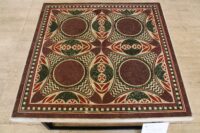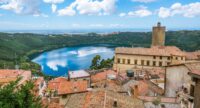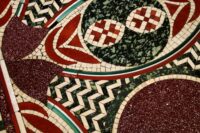 A section of mosaic flooring from one of the Nemi Roman ships, lavish floating palaces built by the profligate Emperor Caligula, that for decades was used a coffee table by a couple in New York City has gone on permanent display at the Museum of Roman Ships in Nemi. Antique dealer Helen Fioratti and her husband Nereo acquired the opus sectile mosaic in Italy in the 1960s. The broker claimed it had belonged to the noble Barberini family, but there was no ownership record. The Fiorattis had it mounted in a marble frame and put it on a pedestal in their living room where it served as coffee table and much-admired conversation piece in their Park Avenue apartment for 40 years.
A section of mosaic flooring from one of the Nemi Roman ships, lavish floating palaces built by the profligate Emperor Caligula, that for decades was used a coffee table by a couple in New York City has gone on permanent display at the Museum of Roman Ships in Nemi. Antique dealer Helen Fioratti and her husband Nereo acquired the opus sectile mosaic in Italy in the 1960s. The broker claimed it had belonged to the noble Barberini family, but there was no ownership record. The Fiorattis had it mounted in a marble frame and put it on a pedestal in their living room where it served as coffee table and much-admired conversation piece in their Park Avenue apartment for 40 years.
Its secret identity was first rediscovered in 2013 when Dario Del Bufalo, an expert in ancient marbles and author of several books on the subject, was in Manhattan for a book signing. His book on porphyry included an old photograph of the mosaic, which has unusual circular tiles made of the precious dark red marble. He was able to authenticate the panel as one of the luxurious decorations salvaged from the ships thanks to those circles of porphyry and a crack that had been restored. The museum that housed the Nemi ships burned down in 1944 in a battle between Allied forces and the Nazi troops occupying the museum. The hulls of the ships, raised in an arduous lake-draining operation the late 1920s and early 30s, were destroyed in the fire, an incalculable loss, as were many of its salvaged parts.
The mosaic was not in the museum at the time. It was removed before 1944 eventually, nobody knows how, wound up in an antiques shop in Rome couple of decades later. After a four-year investigation, the mosaic was seized by the Manhattan DA’s office and returned to the Italian consulate in October 2017. It has been displayed at temporary exhibits in Italy since its repatriation, but now has a permanent home with the other rare surviving artifacts from Caligula’s great floating palaces.
 Lake Nemi was sacred to the goddess Diana. She was worshipped in a sacred grove on its slopes as far back as the 6th century B.C., and the Temple of Diana Nemorensis was built on the north shore around 300 B.C. By the time of Caligula, it was a popular pilgrimage site. By Roman law, no ship could sail on sacred waters. Caligula probably complied with the letter of the law by keeping them mostly anchored. He also built temples on board — both ships had rotating statue platforms believed to have been used for cult figures — which gave him another loophole to the no sailing on sacred waters law. As a devotee of Isis who was syncretically identified with Diana, he likely used his superyachts on her sacred lake to throw lavish parties for religious festivals like the Isidis Navigium, an annual celebration invoking the protection of Isis on sailors at the opening of the navigation season on March 5th.
Lake Nemi was sacred to the goddess Diana. She was worshipped in a sacred grove on its slopes as far back as the 6th century B.C., and the Temple of Diana Nemorensis was built on the north shore around 300 B.C. By the time of Caligula, it was a popular pilgrimage site. By Roman law, no ship could sail on sacred waters. Caligula probably complied with the letter of the law by keeping them mostly anchored. He also built temples on board — both ships had rotating statue platforms believed to have been used for cult figures — which gave him another loophole to the no sailing on sacred waters law. As a devotee of Isis who was syncretically identified with Diana, he likely used his superyachts on her sacred lake to throw lavish parties for religious festivals like the Isidis Navigium, an annual celebration invoking the protection of Isis on sailors at the opening of the navigation season on March 5th.
Despite being built to the exacting standards of Roman seagoing vessels — their hulls were clad in lead sheets to prevent the depredations of shipworms which do not live in freshwater lakes and both ships were equipped with long steering oars — Caligula’s barges couldn’t have done much sailing on the lake even if hadn’t been a sacrilege to do so. Nemi is a small, roughly circular lake formed from the crater of an extinct volcano. Its average width is 1 kilometer. The barges were 73 x 24 meters and 70 x 20 meters, so it only would have taken a voyage of 14 ship lengths to cross its full width. They were lake palaces, not a means of transport, and if they left the shore at all, they were at most rowed (in the case of the smaller boat) and/or towed (the larger had no means of propulsion) to the center of the lake.
Suetonius cites Caligula’s opulent taste in ships as an example of his profligacy in The Lives of the Twelve Caesars:
He built two ships with ten banks of oars, after the Liburnian fashion, the poops of which blazed with jewels, and the sails were of various parti-colours. They were fitted up with ample baths, galleries, and saloons, and supplied with a great variety of vines and other fruit-trees. In these he would sail in the day-time along the coast of Campania, feasting amidst dancing and concerts of music.
 The Nemi ships had the same luxurious decorations and amenities, even though they had nowhere to go, as attested to by the floor mosaic which is of highest quality in materials and craftsmanship.
The Nemi ships had the same luxurious decorations and amenities, even though they had nowhere to go, as attested to by the floor mosaic which is of highest quality in materials and craftsmanship.
Today the museum houses 1/5th scale replicas of the ships, although last summer the mayor of Nemi was making noises about asking Germany to fund full-scale replicas by way of reparations. The problem with that notion is that there is no direct evidence that the Nazis burned the ships. Allied planes bombed the museum striking at the German anti-aircraft artillery nest which was deliberately installed there in the hope that priceless archaeological patrimony would act as a shield. The bomb drop did minimal damage to the exterior of the museum, and hours later museum staffers saw Nazi occupiers with torches walking around inside just before the fire broke out the night of May 31st. The Germans cleared out that night. US ground troops arrived four days later.
Here’s a silent but deadly (in a good way) British Pathé newsreel documenting the exposure of one of the ships in 1930.